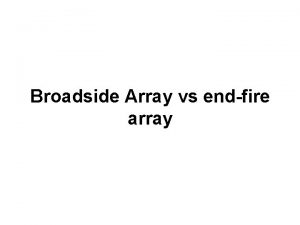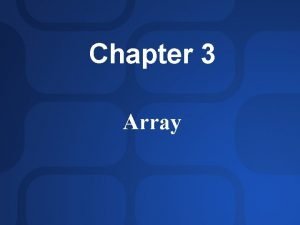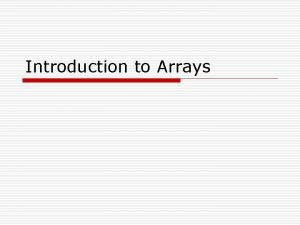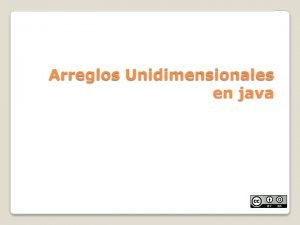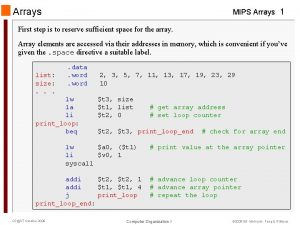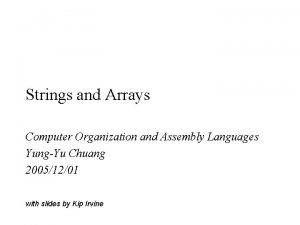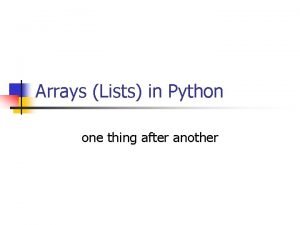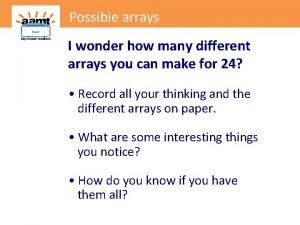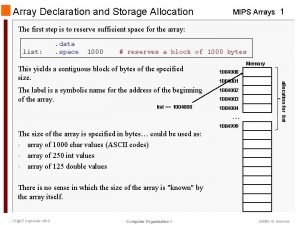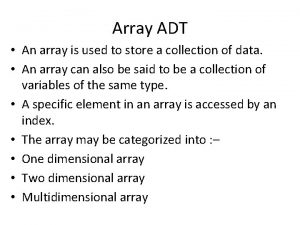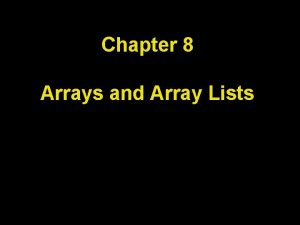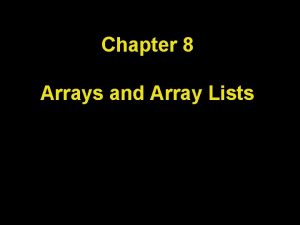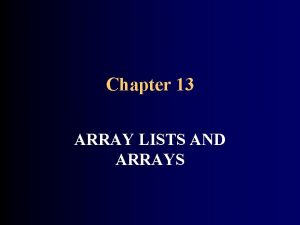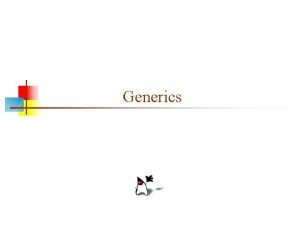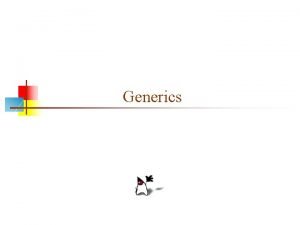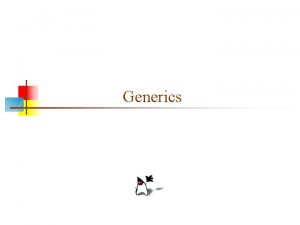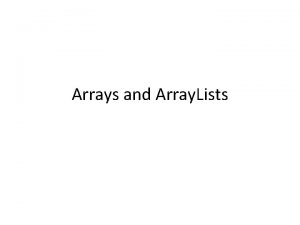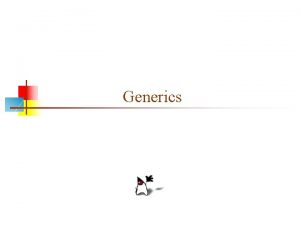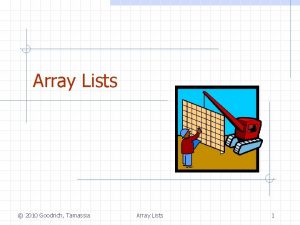Chapter 7 Arrays and Array Lists Chapter Goals



































- Slides: 35

Chapter 7 – Arrays and Array Lists

Chapter Goals To collect elements using arrays and array lists To use the enhanced for loop for traversing arrays and array lists To learn common algorithms for processing arrays and array lists To work with two-dimensional arrays To understand the concept of regression testing

Array Lists An array list stores a sequence of values whose size can change. An array list can grow and shrink as needed. Array. Listclass supplies methods for many common tasks, such as inserting and removing elements. An array list expands to hold as many elements as needed.

Syntax 7. 4 Array Lists

Declaring and Using Array Lists To declare an array list of strings Array. List<String> names = new Array. List<String>(); To use an array list import java. util. Array. List; Array. Listis a generic class Angle brackets denote a type parameter Replace Stringwith any other class to get a different array list type

Declaring and Using Array Lists Array. List<String>is first constructed, it has size 0 Use the addmethod to add an object to the end of the array list: names. add("Emily"); // Now names has size 1 and element "Emily" names. add("Bob"); // Now names has size 2 and elements "Emily", "Bob" names. add("Cindy"); // names has size 3 and elements "Emily", "Bob", and "Cindy" The sizemethod gives the current size of the array list. Size is now 3 Figure 17 Adding an Array List Element with add

Declaring and Using Array Lists To obtain an array list element, use the getmethod Index starts at 0 To retrieve the name with index 2: String name = names. get(2); // Gets the third element of the array list The last valid index is names. size() - 1 A common bounds error: int i = names. size(); name = names. get(i); // Error To set an array list element to a new value, use the setmethod: names. set(2, "Carolyn");

Declaring and Using Array Lists An array list has methods for adding and removing elements in the middle. This statement adds a new element at position 1 and moves all elements with index 1 or larger by one position. names. add(1, "Ann") The remove method, removes the element at a given position moves all elements after the removed element down by one position and reduces the size of the array list by 1. names. remove(1); To print an array list: System. out. println(names); // Prints [Emily, Bob, Carolyn]

Declaring and Using Array Lists Figure 18 Adding and Removing Elements in the Middle of an Array List

Using the Enhanced for Loop with Array Lists You can use the enhanced for loop to visit all the elements of an array list Array. List<String> names =. . . ; for (String name : names) { System. out. println(name); } This is equivalent to: for (int i = 0; i < names. size(); i++) { String name = names. get(i); System. out. println(name); }

Copying Array Lists Copying an array list reference yields two references to the same array list. After the code below is executed Both namesand friendsreference the same array list to which the string "Harry"was added. Array. List<String> friends = names; friends. add("Harry"); Figure 19 Copying an Array List Reference To make a copy of an array list, construct the copy and pass the original list into the constructor: Array. List<String> new. Names = new Array. List<String>(names);

Working with Array Lists Array. List<String> names = new Array. List<String>(); Constructs an empty array list that can hold strings. names. add("Ann"); names. add("Cindy"); Adds elements to the end. System. out. println(names); Prints [Ann, Cindy]. names. add(1, "Bob"); Inserts an element at index 1. names is now [Ann, Bob, Cindy]. names. remove(0); Removes the element at index 0. names is now [Bob, Cindy]. names. set(0, "Bill"); Replaces an element with a different value. names is now [Bill, Cindy]. String name = names. get(i); Gets an element. String last = names. get(names. size() - 1); Gets the last element. Array. List<Integer> squares = new Array. List<Integer>(); for (int i = 0; i < 10; i++) { squares. add(i * i); } Constructs an array list holding the first ten squares.

Wrapper Classes You cannot directly insert primitive type values into array lists. Like truffles that must be in a wrapper to be sold, a number must be placed in a wrapper to be stored in an array list. Use the matching wrapper class.

Wrapper Classes To collect double values in an array list, you use an Array. List<Double>. if you assign a doublevalue to a Doublevariable, the number is automatically “put into a box” Called auto-boxing: Automatic conversion between primitive types and the corresponding wrapper classes: Double wrapper = 29. 95; Wrapper values are automatically “unboxed” to primitive types double x = wrapper; Figure 20 A Wrapper Class Variable

Using Array Algorithms with Array Lists The array algorithms can be converted to array lists simply by using the array list methods instead of the array syntax. Code to find the largest element in an array: double largest = values[0]; for (int i = 1; i < values. length; i++) { if (values[i] > largest) { largest = values[i]; } } Code to find the largest element in an array list double largest = values. get(0); for (int i = 1; i < values. size(); i++) { if (values. get(i) > largest) { largest = values. get(i); } }

Storing Input Values in an Array List To collect an unknown number of inputs, array lists are much easier to use than arrays. Simply read the inputs and add them to an array list: Array. List<Double> inputs = new Array. List<Double>(); while (in. has. Next. Double()) { inputs. add(in. next. Double()); }

Removing Matches To remove elements from an array list, call the removemethod. Error: skips the element after the moved element Array. List<String> words =. . . ; for (int i = 0; i < words. size(); i++) { String word = words. get(i); if (word. length() < 4) { Remove the element at index i. } } Concrete example Should not increment iwhen an element is removed

Removing Matches Pseudocode If the element at index i matches the condition Remove the element. Else Increment i. Use a whileloop, not a forloop int i = 0; while (i < words. size()) { String word = words. get(i); if (word. length() < 4) { words. remove(i); } else { i++; } }

Choosing Between Array Lists and Arrays For most programming tasks, array lists are easier to use than arrays Array lists can grow and shrink. Arrays have a nicer syntax. Recommendations If the size of a collection never changes, use an array. If you collect a long sequence of primitive type values and you are concerned about efficiency, use an array. Otherwise, use an array list.

Choosing Between Array Lists and Arrays

section_7/Largest. In. Array. List. java 1 2 3 4 5 6 7 8 9 10 11 12 13 14 15 16 17 18 19 20 21 22 23 24 25 26 27 28 29 30 31 32 33 34 35 import java. util. Array. List; import java. util. Scanner; /** This program reads a sequence of values and prints them, marking the largest value. */ public class Largest. In. Array. List { public static void main(String[] args) { Array. List<Double> values = new Array. List<Double>(); // Read inputs System. out. println( "Please enter values, Q to quit: "); Scanner in = new Scanner(System. in); while (in. has. Next. Double()) { values. add(in. next. Double()); } // Find the largest value double largest = values. get(0); for (int i = 1; i < values. size(); i++) { if (values. get(i) > largest) { largest = values. get(i); } } // Print all values, marking the largest for (double element : values) Program Run: Please enter values, Q to quit: 35 80 115 44. 5 Q 35 80 115 <== largest value 44. 5

Self Check 7. 35 Declare an array list primesof integers that contains the first five prime numbers (2, 3, 5, 7, and 11). Answer: Array. List<Integer> primes = new Array. List<Integer>(); primes. add(2); primes. add(3); primes. add(5); primes. add(7); primes. add(11);

Self Check 7. 36 Given the array list primesdeclared in Self Check 35, write a loop to print its elements in reverse order, starting with the last element. Answer: for (int i = primes. size() - 1; i >= 0; i--) { System. out. println(primes. get(i)); }

Self Check 7. 37 What does the array list names contain after the following statements? Array. List<String> names = new Array. List<String>; names. add("Bob"); names. add(0, "Ann"); names. remove(1); names. add("Cal"); Answer: "Ann", "Cal"

Self Check 7. 38 What is wrong with this code snippet? Array. List<String> names; names. add(Bob); Answer: The namesvariable has not been initialized.

Self Check 7. 39 Consider this method that appends the elements of one array list to another: public void append(Array. List<String> target, Array. List<String> source) { for (int i = 0; i < source. size(); i++) { target. add(source. get(i)); } } What are the contents of names 1 and names 2 after these statements? Array. List<String> names 1 = new Array. List<String>(); names 1. add("Emily"); names 1. add("Bob"); names 1. add("Cindy"); Array. List<String> names 2 = new Array. List<String>(); names 2. add("Dave"); append(names 1, names 2); Answer: names 1 contains "Emily", "Bob", "Cindy", "Dave"; names 2 contains "Dave"

Self Check 7. 40 Suppose you want to store the names of the weekdays. Should you use an array list or an array of seven strings? Answer: Because the number of weekdays doesn’t change, there is no disadvantage to using an array, and it is easier to initialize: String[] weekday. Names = { "Monday", "Tuesday", "Wednesday", "Thursday", “Friday”, "Saturday", "Sunday" };

Self Check 7. 41 The ch 07/section_7 directory of your source code contains an alternate implementation of the problem solution in How To 7. 1 on page 330. Compare the array and array list implementations. What is the primary advantage of the latter? Answer: Reading inputs into an array list is much easier.

Regression Testing Test suite: a set of tests for repeated testing Cycling: bug that is fixed but reappears in later versions Regression testing: involves repeating previously run tests to ensure that known failures of prior versions do not appear in new versions

Regression Testing - Two Approaches Organize a suite of test with multiple tester classes: Score. Tester 1, Score. Tester 2, . . . public class Score. Tester 1 { public static void main(String[] args) { Student fred = new Student(100); fred. add. Score(10); fred. add. Score(20); fred. add. Score(5); System. out. println("Final score: " + fred. final. Score()); System. out. println("Expected: 30"); } } Provide a generic tester, and feed it inputs from multiple files.

section_8/Score. Tester. java Generic tester: 1 2 3 4 5 6 7 8 9 10 11 12 13 14 15 16 17 18 19 20 21 import java. util. Scanner; public class Score. Tester { public static void main(String[] args) { Scanner in = new Scanner(System. in); double expected = in. next. Double(); Student fred = new Student(100); while (in. has. Next. Double()) { if (!fred. add. Score(in. next. Double())) { System. out. println( "Too many scores. "); return; } } System. out. println( "Final score: " + fred. final. Score()); System. out. println( "Expected: " + expected); } }

Input and Output Redirection Section_8/input 1. txt 30 10 20 5 Type the following command into a shell window Input redirection java Score. Tester < input 1. txt Program Run: Final score: 30 Expected: 30 Output redirection: java Score. Tester < input 1. txt > output 1. txt

Self Check 7. 42 Suppose you modified the code for a method. Why do you want to repeat tests that already passed with the previous version of the code? Answer: It is possible to introduce errors when modifying code.

Self Check 7. 43 Suppose a customer of your program finds an error. What action should you take beyond fixing the error? Answer: Add a test case to the test suite that verifies that the error is fixed.

Self Check 7. 44 Why doesn't the Score. Testerprogram contain prompts for the inputs? Answer: There is no human user who would see the prompts because input is provided from a file.
 Strategic goals tactical goals operational goals
Strategic goals tactical goals operational goals Strategic goals tactical goals operational goals
Strategic goals tactical goals operational goals Array of arrays c++
Array of arrays c++ Pin grid array
Pin grid array Endfire array
Endfire array General goals and specific goals
General goals and specific goals Examples of generic goals and product-specific goals
Examples of generic goals and product-specific goals Array yang sangat banyak elemen nol-nya, dikenal sebagai
Array yang sangat banyak elemen nol-nya, dikenal sebagai Jagged array
Jagged array Associative array vs indexed array
Associative array vs indexed array Apa itu menginisialisasi
Apa itu menginisialisasi Suatu array dikatakan upper triangular jika
Suatu array dikatakan upper triangular jika Python 2 dimensional array
Python 2 dimensional array Photovoltaic array maximum power point tracking array
Photovoltaic array maximum power point tracking array Dynamic arrays and amortized analysis
Dynamic arrays and amortized analysis Searching and sorting arrays in c++
Searching and sorting arrays in c++ Array advantages and disadvantages
Array advantages and disadvantages Parallel arrays examples
Parallel arrays examples Parallel arrays
Parallel arrays Veteork
Veteork C++ parallel arrays
C++ parallel arrays Why do we need arrays?
Why do we need arrays? Arreglo unidimensional java
Arreglo unidimensional java Arreglos bidimensionales java
Arreglos bidimensionales java Mips array example
Mips array example Polynomial representation using arrays
Polynomial representation using arrays Arrays in arm assembly
Arrays in arm assembly Global arrays in c
Global arrays in c Computer science arrays
Computer science arrays Arrays visual basic
Arrays visual basic Python parallel arrays
Python parallel arrays I wonder is it possible
I wonder is it possible Arrays in pascal
Arrays in pascal Mips array example
Mips array example Creating arrays matlab
Creating arrays matlab Array adt
Array adt




